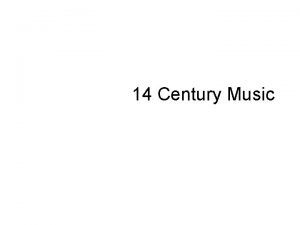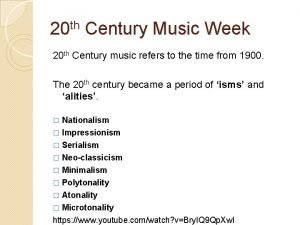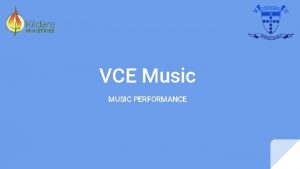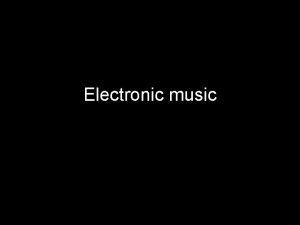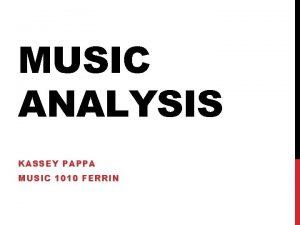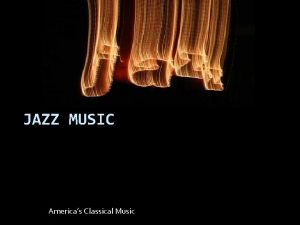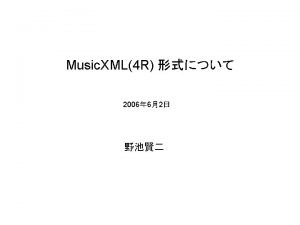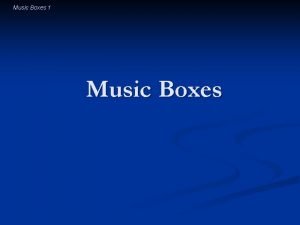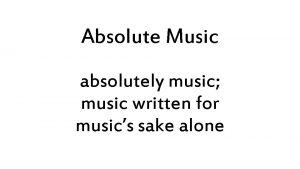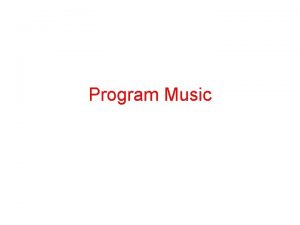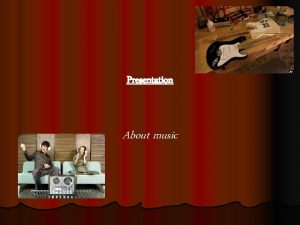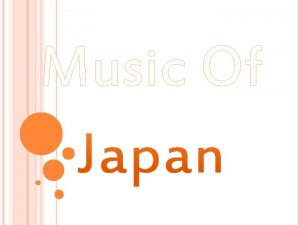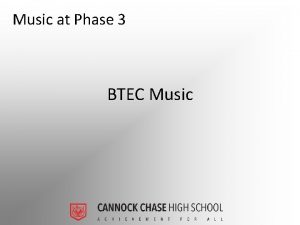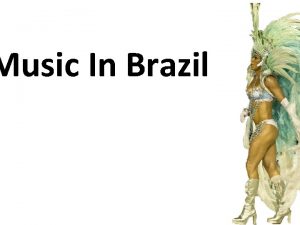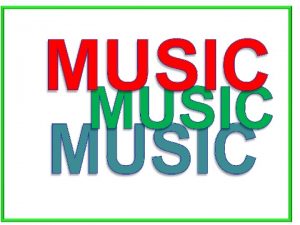Music in the 20 th Century Music from
























- Slides: 24

Music in the 20 th Century Music from 1900 -1945 (Pre-World War II)

The turn of the century Technology reaches dizzying heights. Mass communication – radio, TV, satellites, computers, the internet. Medical sciences conquer infectious diseases and prolong life. WWI & WWII Socio-economic gap expands.

History and the Arts, 1900 -1939 1900 – Europe and US in period of economic stability and peace. Modernism – optimistic experimentation and revolutionary new styles. Composers reject tonality and rhythmic norms. Impressionism & expressionism. WWI shattered sense of optimism. (40 million died; 20 million wounded) Bolshevik revolution and spread of Communism. Great Depression (1929 -1933) Prohibition, women’s right to vote, New Deal.

History and the Arts 1939 -2000 WWII brings more death and destruction to Europe and Far East. l 30 million died, artwork destroyed, economic and political outlook in shambles. Immigration of refugees to US. Cold War Art, music and literature tend toward intellectualism over emotionalism. Radical experimentation in sound led to use of technology and development of popular music. Cubism, post-modernism.

Arnold Schonberg Viennese composer who invented a new system that would “free music from the tyranny of tonality. ” Twelve-tone system – Each pitch is equal, no tonal center, no key. Pantonality (all-tonality) vs. atonality (nontonal). Allowed for new chord combinations and changed significance of consonance vs. dissonance.

Twelve-Tone Music Each pitch is equal, there is no tonal center. Each pitch must sound before any can be repeated. Tone row – The “melody” Retrograde – Tone row played backwards. Inversion – Tone row played inverted. Retrograde inversion - Tone row played backwards and inverted. Tone clusters – Adjacent pitches sounding at once. Twelve-tone harmony.

Other Scales and Modes Pentatonic scale – five note scale. Whole-tone scale – moves entirely by whole steps. Medieval modes. Polytonality – 2 or more keys played at the same time. Quartal chords – built on fourths instead of thirds.

More Musical Changes in 20 th Century Melody – very erratic and unexpected. Rhythm – Complicated, based on African or Indian music. Quarter tones – pitches between half steps. New instruments and old instruments played in new ways. Theremin is first electronic instrument.

Impressionism Originally an artistic movement in which lines are blurred and details are left to the viewer’s imagination. Impressionist music is also harmonically vague and fluid and is meant to symbolize something. Claude Debussy – Composer Claude Monet - Painter

Primitivism and Cubism Artists became attracted to direct, instinctive and exotic cultures. Gaugin, Picasso Les Demoiselles d’Avignon Sigmund Freud explores the power of the unconscious mind. Igor Stravinsky uses primitivism in music.

Igor Stravinsky Born in St. Petersburg, Russia Originally studied law. Started music lessons at age 21 with Rimsky-Korsakov. l Learned techniques in orchestration. 1910 – moved to Paris. Produced works for Ballets Russes (Serge Diaghilev) Polyrhythms, bitonality, ostinato (repeated patterns). Firebird, The Rite of Spring, Petrushka.

More on Stravinsky Influenced by Jazz. Later music in Neo-Classical style (Pulcinella) Wrote a Mass and an opera called, The Rake’s Progress Started writing music for films. Twelve-tone music included an elegy for JFK, and a Requiem (in anticipation of his own death). Highly rhythmic, unusual orchestration, original harmony (often with two tonal centers).

Expressionism Artistic movement rooted in Germany, Norway and Vienna. Klimt and Kokoschka – artists Schoenberg, Berg, Webern – composers Focus on inner states of being and evocation of extreme emotions (anguish, fear, hatred and death).

Arnold Schoenberg Born in Vienna to Orthodox Jewish family. Felt that tonality had outlived its usefulness. Wrote atonal music. Stopped writing during WWI. Twelve-tone music offered a unifying principle to atonal music. Variations for Orchestra, Moses and Aaron (opera). Fired when Nazis took over and fled to USA.

Alban Berg Both students of Schoenberg. Berg’s opera, Wozzeck, is the first atonal Expressionist opera (a masterpiece of 20 th Century music). l Shows his view of war. Berg uses strict forms (sonata, rondo, fugue, symmetry).

Anton Webern Student of Schoenberg Link to first stages of Modernism. Minimalism – everything was understated and there is never an extra note. Wrote detailed instructions in his scores. Short pieces (1 -10 minutes). Studied Renaissance music and used imitative counterpoint.

Bela Bartok Hungarian composer influenced by the nationalist movement. Toured Europe recording and notating folk music of various cultures (ethnomusicology). Known for piano music and string quartets. Music of other cultures influenced his music.

Dmitri Shostakovich Russian composer who lived most of his life under Soviet Communism. Music of Soviet Union was supposed to represent the policies of the state. Fought for creative freedom against demands of a totalitarian state. Composed 15 symphonies & 15 string quartets. Musical “signature” in his music.

Benjamin Britten English composer. Child prodigy. Began composing at 5. The Young Person’s Guide to the Orchestra Operas – Peter Grimes, Billy Budd, Gloriana, The Turn of the Screw. War Requiem – written for dedication of new cathedral in Coventry that was destroyed in WWII. l Mixed old with new (Latin text with poems by Wilfred Owen).

American Composers William Billings – psalms and choral music. Lowell Mason – Hymns and music education. Mostly influenced by European music. l Inner turmoil – Civil War, Reconstruction Shape-notes Spirituals Jazz

Charles Ives First American Modernist composer (avant-garde). Insurance salesman who composed in spare time. Experimental in his ideas of music. Wrote music in two keys at the same time. l The Unanswered Question (Two ensembles play two different songs at the same time. ) Patriotic music.

Aaron Copland Much more mainstream composer than Ives. Studied composition in Europe with Nadia Boulanger (most famous composition teacher of the 20 th Century). Wrote in an American style by drawing on jazz. Ballets – Billy the Kid, Rodeo Appalachian Spring & Fanfare for the Common Man

George Gershwin Composed popular songs and jazz pianist. Also wrote classical pieces. Rhapsody in Blue, An American in Paris, Porgy and Bess (opera). Wrote musical plays with brother, Ira. Died at age 38 of brain tumor.

Leonard Bernstein Continued blending popular and classical styles. Conductor of New York Philharmonic. Musicals – On the Town, Candide, Wonderful Town, West Side Story Choral music and symphonic music.
 Online music portfolio
Online music portfolio điện thế nghỉ
điện thế nghỉ Các châu lục và đại dương trên thế giới
Các châu lục và đại dương trên thế giới Dạng đột biến một nhiễm là
Dạng đột biến một nhiễm là Nguyên nhân của sự mỏi cơ sinh 8
Nguyên nhân của sự mỏi cơ sinh 8 Bổ thể
Bổ thể độ dài liên kết
độ dài liên kết Phép trừ bù
Phép trừ bù Thiếu nhi thế giới liên hoan
Thiếu nhi thế giới liên hoan Tia chieu sa te
Tia chieu sa te Bài hát chúa yêu trần thế alleluia
Bài hát chúa yêu trần thế alleluia Một số thể thơ truyền thống
Một số thể thơ truyền thống Sơ đồ cơ thể người
Sơ đồ cơ thể người Bảng số nguyên tố lớn hơn 1000
Bảng số nguyên tố lớn hơn 1000 Cong thức tính động năng
Cong thức tính động năng đặc điểm cơ thể của người tối cổ
đặc điểm cơ thể của người tối cổ Tỉ lệ cơ thể trẻ em
Tỉ lệ cơ thể trẻ em Các châu lục và đại dương trên thế giới
Các châu lục và đại dương trên thế giới ưu thế lai là gì
ưu thế lai là gì Thẻ vin
Thẻ vin Môn thể thao bắt đầu bằng từ đua
Môn thể thao bắt đầu bằng từ đua Tư thế ngồi viết
Tư thế ngồi viết Cái miệng bé xinh thế chỉ nói điều hay thôi
Cái miệng bé xinh thế chỉ nói điều hay thôi Hình ảnh bộ gõ cơ thể búng tay
Hình ảnh bộ gõ cơ thể búng tay Từ ngữ thể hiện lòng nhân hậu
Từ ngữ thể hiện lòng nhân hậu

























